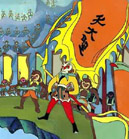
Background information for teaching journey to the west
Roberta E. Adams Additional Document
Many approaches can be taken when teaching excerpts from Journey to the West, a novel that incorporates the three major religions and philosophies of China: Confucianism, Daoism and Buddhism. This introduction centers on Buddhist elements within the text, with the goal of providing instructors with background materials to enlarge their understanding of the text, whether spending one day on an excerpt or one or two weeks on a larger reading selection from the novel. See also: |
The mythic framework is established in Chapter 1, which begins with a brief description of creation, the five elements, yin/yang, and the formation of the three powers of Heaven, Earth, and Man. The narrative then quickly moves to the Mountain of Flowers and Fruit in the Eastern Continent, to tell of Monkey’s birth from a magic stone. As Monkey bows to the four quarters, his far-seeing eyes send out two beams of golden light that startle the Jade Emperor in Heaven. Throughout the text, the action moves back and forth between heaven and earth. While the journey is taking place in the “real” human world, and the pilgrims supposedly reach India, the places they pass through have little or no connection to actual places; the final goal is to reach Buddha on Vulture Peak, Spirit Mountain, a supernatural realm. Sometimes Monkey or another of the immortal disciples physically leaves earth to return to Heaven for help; immortal beings are also plentiful in the mundane world.


